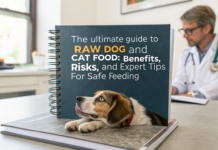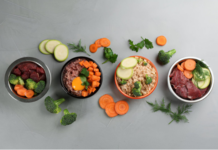Last Updated on April 25, 2024 by Dogs Vets
Anyone who’s ever read a dog training blog, forum or social media post has seen the term ‘high-value dog treats’. However, many people don’t know what this term means, and it can be confusing.
Basically, high-value dog treats are treats that your dog pays attention to and wants very much. These vary from dog to dog, as every dog has a preference thanks to their taste buds, just like humans.
When trying to find high-value treats your pet will love, you need to experiment and see which tasty morsels they gravitate towards and the ones that they aren’t as keen on.
This takes a lot of trial and error, but there are some ways to speed this up, such as finding universally beloved flavours and products.
If you’re looking for inspiration for high-value dog treats for your pup, then here are some popular options.
Raw Dog Food
A lot of trainers suggest using your dog’s normal food as their training snacks so you don’t overfeed your dog. Unfortunately, traditional dog kibbles and dried treats often have the flavour cooked out of them, meaning they’re not as tempting to dogs as fresh foods.
Thankfully, if you feed your dog delicious raw dog food, then they’ll already be incredibly attracted to their meals. What’s more, providers like Southend Dog Training offer cold pressed and raw dog food in the same flavours, so you can feed your dog their raw range and treat them to cold pressed kibbles while you’re out and about.
That way, your dog won’t get tired of their food and will enjoy high-value, easily stored kibbles during training.
Peanut Butter
For times when a liquid or semi-liquid treat is acceptable, such as when muzzle training your dog, peanut butter can be a great high-value choice.
Not only is peanut butter highly palatable and motivating for most dogs, but it’s also healthy, as it provides a source of protein and healthy fats that can be stuffed into treat-dispensing toys or used as a topping for other treats.
It’s important when feeding peanut butter to your dog that you check the ingredients list, as additives such as Xylitol can be poisonous to dogs.
These ingredients are usually found in flavoured peanut butter spreads or cheaper varieties, so make sure you check the ingredients list to ensure you don’t give your dog anything they can’t digest.
Fish
If you’re looking for a particularly smelly treat that will break your dog’s concentration and make them pay all their attention to you, then sardines or salmon, whether canned or cooked, could be the perfect solution.
These fishes are rich in omega-3 fatty acids that support healthy skin and coat, and they provide a concentrated source of protein and essential nutrients with a strong aroma that can be highly enticing for dogs.
It can be hard to carry fish around with you, so it’s one to use at home or somewhere that has access to a shared fridge, such as a dedicated dog training centre.
Cheese
It’s a well-known fact that dogs love cheese. Many types of cheese, particularly naturally flavourful ones like cheddar and gouda, are highly palatable for dogs due to their strong aroma and flavour. These cheeses offer a good source of protein and calcium while being easy to break into smaller pieces for training rewards.
While almost every cheese apart from blue cheese is safe for dogs, you shouldn’t feed them too much. That’s because cheese is high in salt and fat, and can make your dog sick or overweight if given to them in large amounts. Therefore, it’s the perfect option for a high-value, occasional training treat.
What To Do Once You’ve Found Your Dog’s Favourite
Once you’ve figured out which treats your dog loves, you need to start limiting them and only providing them during training sessions or when your dog does something you’re very pleased with. If you hand out high-value treats all the time, then your dog won’t find them special anymore.
Also, you should vary their treats so they don’t have the same thing all the time and get tired of it. This approach will ensure that you always have something to tempt your dog during training and in everyday situations when you need them to do as they’re told.
Facts Check
We hope you enjoyed this article… What are your thoughts?
Please feel free to share this article!
We strive to provide the latest valuable information for pet lovers with accuracy and fairness. If you would like to add to this post or advertise with us, don’t hesitate reach us.
If you see something that doesn’t look right, contact us!

















